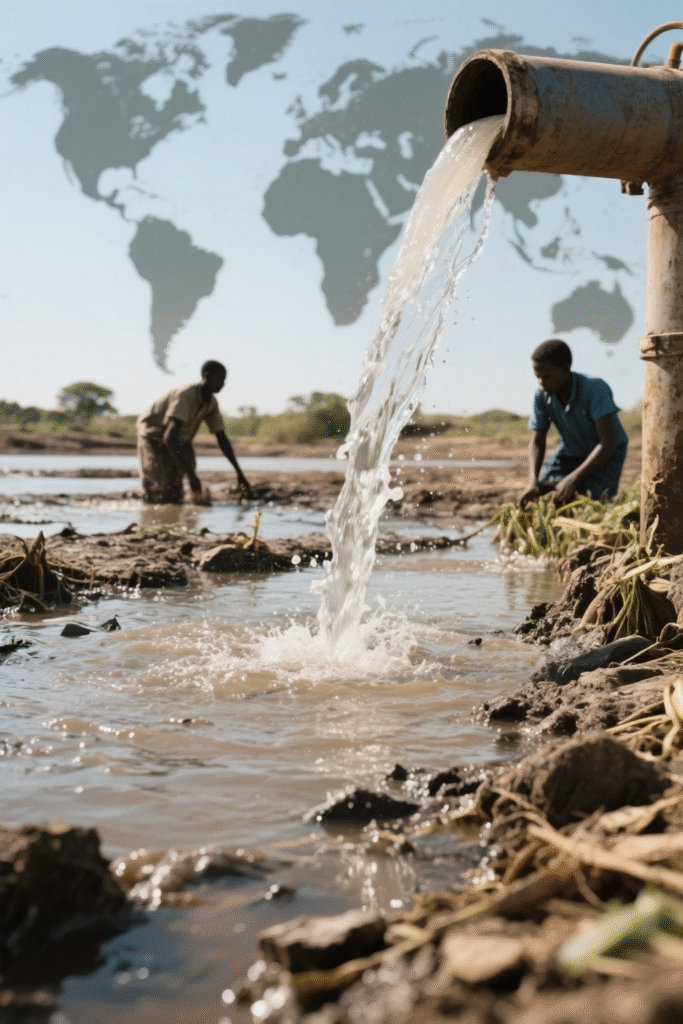Indigenous Peoples: Celebrating Their Unique Heritage
The world’s indigenous cultures are a vibrant testament to the diversity and richness of human experience. With a history spanning thousands of years, these communities have developed unique traditions, languages, and practices that are integral to their identities.

Celebrating the heritage of indigenous peoples is not only a recognition of their past but also an acknowledgment of their ongoing contributions to our global community. Their knowledge, art, and resilience continue to inspire and educate us.
Key Takeaways
- Indigenous cultures are rich in diversity and heritage.
- Celebrating indigenous heritage acknowledges their past and present contributions.
- Indigenous knowledge and art continue to inspire globally.
- Recognizing indigenous peoples’ unique traditions fosters global understanding.
- Their resilience is a testament to the strength of indigenous cultures.
The Global Landscape of Indigenous Peoples Today
The world’s indigenous peoples are a diverse and vibrant group, with a rich cultural heritage that spans the globe. They are found on every continent, with a presence in almost every country.
Definition and Recognition in International Context
The definition of indigenous peoples is complex and has been the subject of much debate. The United Nations defines indigenous peoples as the descendants of the original inhabitants of a country or region, who have a distinct cultural, social, and economic identity. Recognition of indigenous peoples’ rights is a critical issue, with many countries still struggling to acknowledge their historical and ongoing struggles.
International organizations, such as the UN, have played a crucial role in promoting the rights of indigenous peoples and providing a platform for their voices to be heard.
Global Distribution and Demographics
Indigenous peoples can be found in almost every region of the world, with significant populations in the Americas, Africa, Asia, and the Pacific. According to the UN, there are over 370 million indigenous peoples worldwide, representing over 5,000 distinct cultures.
The demographics of indigenous peoples vary widely, with some communities facing significant challenges related to poverty, health, and education. However, many tribal communities are also working to revitalize their languages and cultural practices, and to assert their rights to their traditional lands.
Historical Context: The Journey of Indigenous Communities
Understanding the historical context of indigenous peoples requires a nuanced exploration of their pre-colonial existence, the impact of colonization, and their ongoing struggles and resilience.
The history of native tribes is not just a backdrop to their current situation; it is a living, breathing narrative that continues to influence their lives today. It is a story of diverse cultures, complex societies, and a deep connection to their ancestral lands.
Pre-Colonial Existence and Traditional Societies
Before the arrival of colonial powers, indigenous communities thrived with their own distinct cultures, governance systems, and traditional practices. These societies were often highly adapted to their local environments, with sophisticated knowledge systems that allowed them to live in harmony with nature.
The diversity among pre-colonial indigenous peoples was vast, with different tribes having their own languages, spiritual practices, and social structures. This diversity is a testament to the creativity and resilience of native tribes.
Impact of Colonization and Forced Assimilation
The advent of colonization brought about profound changes to indigenous communities, often through violent means, displacement, and the imposition of foreign cultures and belief systems. Forced assimilation policies aimed to erase the identities of indigenous peoples, suppressing their languages, spiritual practices, and cultural traditions.
This period was marked by significant trauma and loss for native tribes, affecting not only their social and cultural fabric but also their economic and political structures.
Modern Historical Challenges and Resilience
In the modern era, indigenous peoples continue to face challenges related to land rights, cultural preservation, and social justice. Despite these challenges, indigenous communities have shown remarkable resilience, working to revitalize their languages, preserve their cultural heritage, and assert their indigenous rights.
Their journey is a powerful testament to the strength and determination of native tribes and their ongoing struggle for recognition and respect in a rapidly changing world.
Native Americans: Case Studies in Cultural Preservation
Preserving cultural heritage is a vital aspect of Native American life, reflecting their deep connection to their ancestors and the land. The diverse indigenous cultures across the United States are a testament to the resilience and determination of Native American communities.
Diverse Tribal Nations Across the United States
The United States is home to a vast array of Native Tribes, each with its own distinct culture, language, and traditions. From the Navajo Nation to the Cherokee Tribe, the diversity among Native American communities is vast, reflecting a rich tapestry of cultural identities.
- Over 570 federally recognized tribes
- Diverse languages and dialects
- Unique cultural practices and traditions
Cultural Practices and Traditions
Native American cultural practices are deeply rooted in their historical and spiritual contexts. These practices not only define their identities but also play a crucial role in their cultural preservation efforts.
Ceremonial Traditions and Their Significance
Ceremonial traditions are a vital part of indigenous cultures, serving as a bridge between the past and the present. These ceremonies often revolve around spiritual beliefs and are crucial for maintaining cultural continuity.
Art Forms and Creative Expression
Native American art forms, including pottery, weaving, and carving, are not only aesthetically significant but also carry deep cultural meanings. These art forms are a testament to the creativity and resilience of Native American communities.
- Pottery and its cultural significance
- Weaving traditions across different tribes
- Carving and its role in storytelling
Contemporary Native American Life
Despite historical challenges, Native American communities continue to thrive, adapting to contemporary circumstances while preserving their cultural heritage. Efforts to revitalize languages, preserve traditional knowledge, and promote cultural education are underway across various Native Tribes.
The future of Native American cultures looks promising, with younger generations actively engaged in cultural preservation and revitalization efforts. Through their resilience and determination, Native American communities are ensuring the continuation of their rich cultural legacy.
First Nations of Canada: Preserving Ancient Wisdom
Canada’s First Nations communities embody a vibrant tapestry of cultures, languages, and traditions. With over 600 recognized First Nations, the cultural diversity is vast, ranging from the Inuit in the north to the Mi’kmaq in the east.
Cultural Diversity Among First Nations
The First Nations in Canada are not a homogeneous group; they have distinct languages, spiritual beliefs, and cultural practices. For instance, the Haida Nation is known for its intricate wood carvings, while the Cree are renowned for their expertise in hunting and gathering. This diversity is a testament to the rich heritage and resilience of indigenous cultures.
Preservation of cultural heritage is crucial for the identity and continuity of First Nations. Efforts to preserve their languages, traditions, and histories are underway, including cultural camps, language immersion programs, and the documentation of oral histories.
Revitalization Movements and Success Stories
Revitalization movements among First Nations are gaining momentum, with a focus on language revitalization, cultural education, and community development. Success stories include the revitalization of the Mi’kmaq language through immersion programs and the revival of traditional practices such as basket weaving and canoe building.
One notable example is the Indigenous Guardians Program, which supports First Nations in protecting their lands, waters, and cultural heritage. This program has seen significant success in preserving indigenous knowledge and promoting sustainable practices.
These efforts underscore the resilience and determination of First Nations communities to preserve their ancient wisdom and cultural heritage for future generations.
Aboriginal Australians: The World’s Oldest Continuous Culture
The Aboriginal Australian culture, with its deep spiritual roots, stands as one of the oldest continuing cultures on Earth. This section delves into the essence of their heritage, exploring their spiritual connection to the land, their vibrant art and storytelling traditions, and the current state of their society.
Dreamtime and Spiritual Connection to Land
Aboriginal Australians have a profound spiritual connection to their land, known as “Country,” which is central to their identity and culture. The Dreamtime, or “Dreaming,” is a complex network of stories, songs, and dances that explain the creation of the land, the laws that govern it, and the people’s place within it.
Their connection to the land is not merely physical but deeply spiritual, involving a belief in ancestral beings that created the land, animals, and people. This belief system underscores their role as custodians of the land, emphasizing a reciprocal relationship where the land provides for them, and they, in turn, care for it.
Art and Storytelling Traditions
Aboriginal art is a vibrant expression of their culture, encompassing a wide range of forms including painting, carving, weaving, and performing arts. Storytelling is an integral part of their cultural heritage, passed down through generations via oral traditions, songs, and dances.
Their art is not just aesthetically significant but also carries deep symbolic meanings, often related to their Dreaming stories. Rock art, for instance, is one of the oldest continuing art forms in the world, with some paintings dating back thousands of years.
Contemporary Aboriginal Australian Society
Today, Aboriginal Australians continue to face challenges related to health, education, and economic disparities. However, there is a strong movement towards revitalizing their culture, language, and traditional practices.
Despite historical traumas, Aboriginal Australians remain resilient, working towards a future that honors their past while embracing the possibilities of the present and future. Their story is one of survival, adaptation, and the ongoing struggle for recognition and rights.
Indigenous Peoples of Latin America: Ancient Civilizations Today
Indigenous peoples in Latin America are the guardians of a rich cultural legacy that spans millennia. The descendants of ancient civilizations such as the Maya, Aztec, and Inca continue to thrive, maintaining their unique cultural identities amidst modern challenges.

Maya, Aztec, and Inca Descendants
The Maya, Aztec, and Inca civilizations were renowned for their sophisticated knowledge systems, including astronomy, agriculture, and architecture. Today, their descendants continue to preserve these ancient traditions. For instance, the Maya communities in Mexico and Guatemala maintain their linguistic diversity and traditional practices, such as weaving and ceremonial rituals.
The Aztec descendants in Mexico honor their ancestors through vibrant cultural festivals and the preservation of their historical memory. Similarly, the Inca descendants in Peru and Bolivia continue their traditional agricultural practices and textile production, which are crucial to their cultural identity.
Cultural Preservation in Modern Context
In the modern context, indigenous peoples face numerous challenges, including cultural assimilation and environmental degradation. Despite these challenges, many communities are successfully preserving their cultural heritage through revitalization efforts, such as language documentation and traditional skills training.
For example, indigenous-led organizations are working to protect sacred sites and promote sustainable development practices that align with traditional knowledge systems. These efforts not only preserve cultural heritage but also contribute to the well-being of local ecosystems.
Tribal Communities of Africa: Diversity and Adaptation
Tribal communities across Africa are known for their resilience and adaptability in the face of changing environmental and socio-political landscapes. These communities have rich cultural heritages and traditional practices that have been passed down through generations.
Traditional Knowledge Systems
African tribal communities possess traditional knowledge systems that are crucial for their survival and cultural identity. This knowledge encompasses a wide range of practices, including agricultural techniques, medicinal uses of plants, and environmental conservation methods. For instance, some communities have developed sophisticated irrigation systems that are adapted to their local environments.
The traditional knowledge of these communities is not only valuable for their own lives but also holds significant potential for contributing to global biodiversity conservation and sustainable development.
Challenges and Resilience
Despite their resilience, tribal communities in Africa face numerous challenges, including land encroachment, cultural assimilation, and climate change. These challenges threaten their very existence and the preservation of their cultural heritage.
However, many of these communities are finding ways to adapt and preserve their traditions. For example, some are using modern technology to document their languages and cultural practices, ensuring their heritage is preserved for future generations.
By understanding and supporting the rights and needs of tribal communities, we can help ensure the continuation of their unique cultural identities and contributions to the world’s cultural diversity.
Indigenous Cultures of Asia and the Pacific
The Asia-Pacific region is home to a vast array of indigenous cultures, each with its distinct customs and beliefs. These communities have maintained their unique identities despite historical challenges and modernization.
Cultural Practices and Belief Systems
Indigenous cultures in Asia and the Pacific are known for their rich spiritual practices and deep connection with nature. For example, many Pacific Island communities have traditional ceremonies that honor the land and the spirits. In Asia, indigenous groups like the Dayak in Borneo and the Igorot in the Philippines have complex belief systems that are intertwined with their daily lives.
The spiritual practices of these communities are not only significant culturally but also play a crucial role in environmental conservation. Many indigenous cultures believe in living in harmony with nature, a principle that is increasingly recognized as vital for sustainable development.
Contemporary Challenges and Adaptations
Despite their rich cultural heritage, indigenous communities in Asia and the Pacific face numerous challenges, including land encroachment, cultural assimilation, and climate change. However, these communities are also adapting and finding ways to preserve their cultures in the modern world.
| Community | Cultural Practice | Challenge | Adaptation |
|---|---|---|---|
| Dayak, Borneo | Traditional tattoos | Cultural assimilation | Revival of tattooing practices among youth |
| Igorot, Philippines | Weaving | Loss of traditional skills | Establishment of weaving schools |
| Maori, New Zealand | Tattoos (Ta Moko) | Cultural appropriation | Education and cultural exchange programs |
The table highlights some of the cultural practices, challenges faced by indigenous communities, and their adaptations. It showcases the resilience and creativity of these communities in preserving their heritage.
The Sacred Connection to Land and Nature
For indigenous peoples, the land is not just a physical territory but a sacred entity that encompasses their history, culture, and spirituality. This profound connection is fundamental to their identity and informs their relationship with the natural environment.
Environmental Stewardship Practices
Indigenous communities have traditionally practiced environmental stewardship, living in harmony with nature. Their traditional knowledge systems have allowed them to maintain ecological balance, preserving biodiversity and ensuring the sustainability of natural resources. These practices are rooted in a deep understanding of local ecosystems and are often guided by spiritual beliefs that emphasize living in harmony with the land.
Land Rights Struggles and Victories
The struggle for land rights is a critical issue for indigenous peoples worldwide. Despite historical injustices and ongoing challenges, indigenous communities have achieved significant victories in their fight for rights. Land rights movements are not just about legal ownership; they are about preserving cultural heritage and ensuring the continuation of traditional ways of life.
Standing Rock: A Case Study
The Standing Rock resistance against the Dakota Access Pipeline is a notable example of an indigenous land rights movement. The Standing Rock Sioux Tribe led a global campaign to protect their water sources and ancestral lands, highlighting the global significance of indigenous rights and environmental justice.
Other Significant Land Rights Movements
Other significant land rights movements include the struggles of the Amazonian indigenous communities against deforestation and mining, and the efforts of the Maori in New Zealand to protect their ancestral lands and resources. These movements underscore the global nature of indigenous rights issues and the importance of international solidarity.
Indigenous Languages: Preserving Linguistic Heritage
Preserving indigenous languages is not just about saving words and grammar; it’s about maintaining the cultural fabric of indigenous cultures. Indigenous languages are a vital part of the identity and heritage of native tribes, holding within them the history, traditions, and stories of their communities.
Language Diversity and Endangerment Status
There are over 7,000 languages spoken worldwide, with a significant portion being indigenous languages. However, many of these languages are considered endangered. According to UNESCO, nearly half of the world’s languages are at risk of falling out of use and disappearing. The main factors contributing to this endangerment include globalization, urbanization, and the dominance of a few major languages.
Some key statistics highlighting the diversity and endangerment status include:
- Over 2,000 languages are spoken in the Asia-Pacific region alone.
- In the Americas, there are approximately 800 indigenous languages.
- Africa is home to more than 2,000 languages, many of which are indigenous.
Revitalization Efforts and Methodologies
Efforts to revitalize indigenous languages are underway globally, involving various methodologies. These include language documentation, education programs, and community engagement. Technology also plays a crucial role, with apps, online courses, and digital dictionaries being developed to support language learning and preservation.
Some successful methodologies include:
- Immersion programs where children are taught in their indigenous language.
- Community language classes for both children and adults.
- Language nests, where elderly speakers teach young children.
Case Studies of Successful Language Preservation
There are several inspiring examples of successful language preservation. For instance, the Hawaiian language was on the brink of extinction in the 1980s but has since seen a resurgence thanks to immersion schools and community programs. Similarly, the Maori language in New Zealand has been revitalized through language nests and educational initiatives.
These examples demonstrate that with concerted effort and community involvement, it is possible to preserve indigenous languages and keep them vibrant for future generations.
Traditional Knowledge and Sustainable Practices
For centuries, indigenous communities have lived in harmony with their environments, guided by traditional knowledge and practices. This knowledge, passed down through generations, encompasses a wide range of sustainable practices that are crucial for environmental conservation and community well-being.
Agricultural and Ecological Wisdom
Indigenous cultures possess a deep understanding of agricultural and ecological practices that are sustainable and environmentally friendly. For example, the practice of crop rotation and polyculture helps maintain soil fertility and reduce pests and diseases. Additionally, traditional knowledge about the medicinal properties of plants has led to the development of numerous modern medicines.
Key aspects of indigenous agricultural wisdom include:
- Use of native crop varieties that are well-suited to local conditions
- Implementation of agroforestry practices that integrate trees into farming systems
- Application of traditional soil conservation techniques
Medicine and Healing Traditions
Traditional knowledge also encompasses medicine and healing traditions that are deeply rooted in indigenous cultures. Many modern medicines have been developed from traditional remedies used by indigenous peoples. For instance, the bark of the willow tree, used by indigenous communities for pain relief, is the source of aspirin.
The importance of preserving traditional medicine lies in its potential to provide new leads for modern drug discovery and its role in maintaining cultural heritage.
Indigenous Peoples: Rights and International Recognition
Indigenous communities worldwide are increasingly asserting their rights and seeking international recognition to preserve their cultures and ways of life. This global movement is driven by the need for respect, understanding, and protection of indigenous peoples’ rights.
UN Declaration on the Rights of Indigenous Peoples
The UN Declaration on the Rights of Indigenous Peoples (UNDRIP) is a landmark document adopted by the United Nations General Assembly in 2007. It emphasizes the rights of indigenous peoples to their lands, territories, and resources, as well as their right to self-determination and cultural preservation.
Key provisions of UNDRIP include:
- Free, prior, and informed consent for projects affecting indigenous lands
- Protection of indigenous cultural heritage
- Right to self-determination and autonomy

Indigenous-Led Movements and Advocacy
Indigenous-led movements are crucial in advocating for the rights of indigenous peoples. These movements use various strategies, including grassroots organizing, international advocacy, and legal action, to bring attention to indigenous issues and push for policy changes.
| Movements/Organizations | Focus Areas | Impact |
|---|---|---|
| Native American Rights Fund | Legal advocacy, tribal sovereignty | Significant legal victories for Native American tribes |
| Global Indigenous Caucus | International advocacy, policy influence | Influenced UN policies and international agreements |
| Aboriginal Rights Coalition | Land rights, cultural preservation | Raised awareness and support for Aboriginal rights |
Legal Victories and Ongoing Challenges
Despite significant legal victories, indigenous peoples continue to face numerous challenges, including land dispossession, cultural erasure, and systemic discrimination. Ongoing advocacy and international cooperation are necessary to address these issues and ensure the full realization of indigenous rights.
Recent legal victories include the recognition of indigenous land rights in various countries and the establishment of protected areas for indigenous communities. However, much work remains to be done to fully implement the principles of UNDRIP and to address the historical injustices faced by indigenous peoples.
Cultural Appropriation vs. Appreciation
In an era of heightened cultural sensitivity, understanding the difference between cultural appropriation and appreciation is crucial. The increasing globalization has led to a complex dynamic where cultural exchange can sometimes result in the misappropriation of indigenous cultures.
Cultural appropriation occurs when elements of a culture are taken out of context and used in a way that is disrespectful or demeaning to the original culture. On the other hand, cultural appreciation involves a genuine respect for and understanding of another culture, often through education and dialogue.
Understanding the Difference Through Case Examples
Several case examples illustrate the fine line between cultural appropriation and appreciation. For instance, the use of Native American headdresses as fashion accessories is widely regarded as cultural appropriation, as it disregards the spiritual and cultural significance of these items. Conversely, collaborations between indigenous artists and non-indigenous brands can be seen as a form of cultural appreciation when done respectfully and with proper understanding and compensation.
- Examples of cultural appropriation include the misuse of sacred symbols and the exploitation of traditional knowledge.
- Examples of cultural appreciation include educational initiatives, respectful cultural exchange programs, and fair trade practices.
Guidelines for Respectful Engagement with Indigenous Cultures
To engage respectfully with indigenous cultures, one must first educate oneself about the culture and its significance. This can involve:
- Learning about the history and traditions of the culture.
- Engaging in dialogue with members of the culture.
- Supporting indigenous-led initiatives and fair trade practices.
By following these guidelines, we can foster a more respectful and appreciative engagement with indigenous cultures, promoting a positive exchange that benefits all parties involved.
The Future of Indigenous Peoples in a Globalized World
Globalization presents a double-edged sword for indigenous peoples, offering new avenues for cultural exchange while threatening their traditional ways of life. As the world becomes more interconnected, it is crucial to consider how indigenous cultures can thrive in this new landscape.
Technology and Cultural Preservation Initiatives
Technology has emerged as a vital tool for indigenous communities seeking to preserve their cultural heritage. Digital archiving initiatives have enabled the preservation of indigenous languages, stories, and traditional knowledge. For instance, language learning apps and online platforms have been developed to teach indigenous languages to new generations.
Moreover, social media and online forums have provided indigenous communities with a global stage to share their stories, raise awareness about their rights, and mobilize support for their causes.
Youth Engagement and Leadership Development
The engagement and leadership of indigenous youth are critical for the future of their communities. Programs aimed at youth empowerment and leadership development have been instrumental in equipping young indigenous individuals with the skills and confidence needed to advocate for their rights and preserve their cultural identities.
These initiatives often combine traditional knowledge with modern skills, ensuring that young indigenous leaders are well-versed in both their cultural heritage and contemporary issues.
Building Cross-Cultural Bridges and Alliances
Building alliances with non-indigenous communities and organizations is essential for promoting cross-cultural understanding and supporting indigenous rights. Collaborative projects between indigenous and non-indigenous peoples can foster mutual respect and appreciation, helping to break down stereotypes and misconceptions.
As
“The future of indigenous peoples is not just about preserving the past, but about building a more inclusive and equitable future for all.”
, said by a prominent indigenous leader, encapsulates the spirit of cooperation and mutual respect that is necessary for moving forward.
Conclusion: Honoring Indigenous Heritage and Supporting Self-Determination
Honoring indigenous heritage and supporting the self-determination of indigenous peoples is crucial in today’s globalized world. Throughout this article, we have explored the diverse cultures, histories, and struggles of indigenous communities worldwide, from Native Americans to Aboriginal Australians.
The rich tapestry of indigenous cultures is a testament to the resilience and adaptability of these communities. Recognizing and respecting indigenous rights is essential for preserving their cultural heritage and promoting their well-being.
By acknowledging the historical injustices faced by indigenous peoples and supporting their struggles for self-determination, we can work towards a more equitable future. This involves not only recognizing their rights but also engaging in respectful and collaborative efforts to preserve indigenous cultures.
As we move forward, it is essential to continue raising awareness about the importance of indigenous cultures and the challenges they face, promoting a culture of understanding and respect for indigenous peoples and their rights.




















